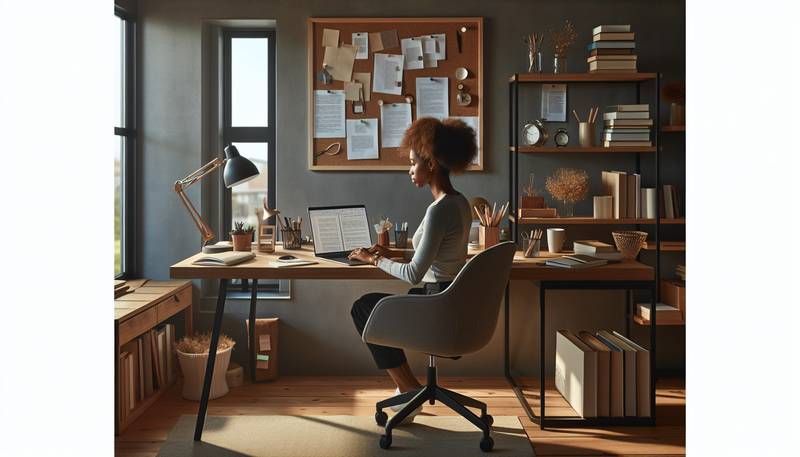Optimizing Your Home Office for Maximum Productivity

Welcome to the ultimate guide for creating a home office that not only looks great but also puts you on the fast track to peak productivity levels. If you're a remote employee, a self-employed entrepreneur, or just someone who thrives when working in a comfy yet efficient personal haven, you've stumbled upon the perfect resource. This isn't just about working from home; it's about creating an environment that's conducive to work, inspires creativity, and keeps the gears of productivity turning from nine to five—and sometimes beyond.
Setting up Your Space for Success
First things first, setting up your space is more than just plunking a desk in a quiet corner of your house—it's about creating a productivity cockpit. Ideally, you want a space that's free from the hustle and bustle of daily home life—not in the path of household traffic, away from the noise of the TV or the whir of the washing machine. Ambient noise isn't just distracting; it can break your workflow, so choosing a spot that buffers you from auditory disturbances is key. Lighting plays a crucial role too. Natural light doesn't just save on your electric bill; it's been shown to improve mood and energy levels. Set your desk near a window if possible, but make sure your computer screen doesn't catch reflections that can strain your eyes. As the sun sets, a combination of overhead lighting and desk lamps can help sustain a steady, comfortable light level.What about furniture? It's more than a style choice; it's about posture and health. A chair with lumbar support, a desk at the right height for your arms and hands, and a setup that allows your feet to rest flat on the ground can make marathon work sessions much more endurable. Setting up your space is the first crucial step to a productive home office—get this right, and you're on your way to success.
Declutter and Organize Like a Pro
Imagine sitting down to work and spending the first fifteen minutes shuffling through piles of papers to find your notes, or rummaging drawers for that one elusive pen. Frustrating, isn't it? That's why decluttering and organizing is not just for the OCD among us—it's essential for streamlined productivity. Start by purging anything non-essential. Those old notes from a completed project? Archive or shred them. That collection of pens that have long since run dry? Bin them.Once you've whittled down your items to the essentials, it's time to organize. Use desk organizers for your stationery, drawer dividers to separate and categorize items, and cable management solutions to avoid the tangled web of cords that somehow materializes whenever tech is involved. A place for everything, and everything in its place, as the old adage goes. You'd be surprised how much time you save—and how it minimizes decision fatigue—when everything you need is neatly arranged and within easy reach.
Tools and Tech to Boost Efficiency
In today's interconnected world, having the right technology at your fingertips can mean the difference between muddling through tasks and blasting through them with efficiency. Equip your space with a reliable computer that can handle all your software needs without hiccupping on performance. Considering a dual monitor setup can radically enhance your multitasking abilities, allowing you to compare documents side-by-side, or keep an eye on correspondence while you work on a report.Software choice is equally important. From project management tools that keep you on top of deadlines, to quick communication platforms that connect you with colleagues instantaneously, selecting the right programs is pivotal. Lean on the marvels of modern tech like cloud storage for easy access to your files from any device, or digital assistants that can schedule appointments and set reminders with a simple voice command.Don't forget about internet speed—you’re going to want a connection that can keep up with your pace. Slow internet can bottleneck your productivity, leaving you watching the dreaded loading icon more often than ticking tasks off your to-do list. Invest in a good quality router, consider a wired connection for stability, and if you’re in a crowded household, look at scheduling bandwidth-hogging tasks for low-traffic times.
The Power of Personalization
Your home office is your own – it should inspire you and fuel your creativity. Personalizing your space is about more than aesthetics; it's about making your environment gel with your work ethic and energy. Colors can have a significant impact on your mood and productivity. For instance, blue can promote calm and focus, while yellow might stimulate creativity. Choose a color palette that resonates with you and incorporate it into your office decor – whether it be through a fresh coat of paint, vibrant artwork, or desk accessories.Adding plants can breathe life into your workspace, literally. They not only purify the air but seeing greenery can reduce stress levels and enhance your mood – creating a more pleasant and productive environment. Personal photos, a vision board, or a favorite piece of motivational literature can also serve as daily reminders of your goals and the loved ones cheering you on.Don't overlook the power of scent, either. If you're someone who responds well to olfactory stimuli, consider an essential oil diffuser with focus-enhancing scents like peppermint or lemon. Remember, this is your space – shape it into a place where you want to spend time, a place that energizes you and helps you find your flow.
Ergonomics: The Key to Comfort and Productivity
Working from home means you'll be spending a lot of time at your desk, so it's important to invest in ergonomics. Ergonomics is the science of designing the workspace to fit within the capabilities and limitations of the worker. This means finding a chair that supports your spine's natural curve, having a desk at a height that doesn't have you hunching over or reaching up for your keyboard, and positioning your monitor so your neck is in a neutral position.Feeling comfortable in your space is more than a luxury – it's about health. Consider an adjustable chair that you can tailor to align with your desk height, ensuring your feet can touch the ground while your thighs stay parallel to the floor. This reduces strain on your legs and back. Your monitor should be at eye level, so you're not tilting your head up or down, which can lead to neck pain. Equip your home office with an external keyboard and mouse if you're using a laptop, to maintain wrist health.Consider a stand-up desk or a desk converter, which allows you to alternate between sitting and standing throughout the day. This not only helps with posture but also keeps your body moving, which is great for circulation and overall energy levels. Ergonomics might sound technical, but it boils down to creating a comfortable space that will keep you working effectively without the risk of pain or injury.
Mastering the Art of Work-Life Balance
One of the biggest challenges when working from home is the blurred line between personal life and work life. To maintain a healthy balance, establish clear boundaries. Set work hours and stick to them, just as you would in a traditional office. This not only helps you stay disciplined but also signals to others in your home when you're "at work" and shouldn't be disturbed.When your workday ends, step away from your home office space. This physical separation helps your mind switch off from work mode. Make the most of your breaks throughout the day, too. Just a few minutes away from your screen for a coffee break or a quick stroll around the block can recharge your batteries and prevent burnout.And remember, flexibility is one of the luxuries of working from home. If your role allows it, take advantage of this by scheduling work during your most productive hours or take longer breaks to run errands or exercise during the day. Work-life balance isn't just about the amount of time you spend at work and at leisure – it's about how energized and present you are in both environments.
Final Thoughts and Additional Resources
Congratulations on making it through the guide to optimizing your home office for productivity. But this isn't the end – it's just the beginning. Consider this your launchpad to a more productive and satisfying work-from-home experience. Experiment with the suggestions in this guide, see what works best for you, and remember, optimization is an ongoing process.To further your journey, there is a wealth of additional resources available. From productivity blogs and ergonomic studies to interior design tips and tech reviews, the information is out there to help you continually refine and improve your space. Podcasts on productivity, social media groups dedicated to remote working, and online forums all serve as invaluable tools as you hone the perfect home office setup.Your workspace should be a reflection of your ambitions, your style, and your commitment to your career. With the right setup, tools, and mindset, there's no ceiling to what you can achieve. Go forth and be productive!


